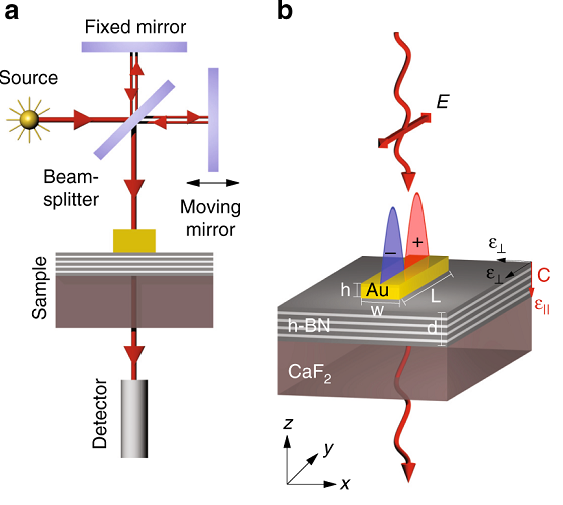Using an optical antenna to launch phonon polaritons in a low-dimensional van der Waals crystal
The so-called van der Waals materials consist of two-dimensional layers bound by weak van der Waals forces. After the isolation of graphene, the field of two-dimensional van der Waals materials has experienced an explosive growth and new families of two-dimensional systems and block-layered bulk materials have been created.
This growth has been fueled mainly by the possibility of tuning a set of remarkable electronic properties using an array of methods (thickness control, doping, intercalation, proximity effects, to name a few) coupled with a relative simplicity of fabrication. These two characteristics, that make layered van der Waals materials similar to Lego constructions, are attractive from both practical and fundamental points of view.
One of the possibilities using van der Waals Lego structures is creating infrared polaritonic crystals. Light confinement can be improved by means of polaritons that, as we know, are modes formed by the coupling of dipolar excitations and electromagnetic fields or, if you prefer, quasiparticles resulting from the strong coupling of photons with a dipole-carrying excitation. Many low-dimensional van der Waals crystals support a diversity of polaritons with unique properties (enormous confinement, tunability, low losses, or negative phase velocity, among others).
Particularly, in the mid-infrared frequency range, precisely the range where all organic materials strongly interact with electromagnetic fields, hexagonal boron nitride (h-BN) crystals exhibit anisotropic phonons and support phonon polaritons – coupling of an infrared photon with an optic phonon, a phonon being a quantum of vibrational energy.
These phonon polaritons are strongly confined, that is, they have extremely short wavelengths (huge momenta) and remarkably long lifetimes. However, due to their large momenta, their direct excitation by an incident plane wave on an unstructured h-BN flake is not possible. In other words, this momentum mismatch (the momentum of waves in free space being much smaller) make the experimetal study of these phonon polaritons very difficult.
Some strategies have been suggested, though. The sharp tip of a near-field microscope, metallic edges, or edges of the h-BN flakes can be used to overcome the momentum mismatch. By structuring the h-BN flakes in the form of cones, rods, or stripes h-BN phononic antennas can be fabricated that exhibit resonances accessible with far-field illumination.

Now a team of researchers, including Ikerbasque Research Associate Alexey Nikitin (DIPC), suggests 1 a very simple technology taken from radiowave engeneering concepts, namely to use an optical antenna to launch phonon polaritons. The use of the resonant metallic antennas is, in general, highly interesting for various optoelectronic applications, such as thermophotovoltaics or photocatalisis, due to their strong plasmonic response and large extinction cross-section. The suggested antenna provides the missing momenta and strongly enhance the electromagnetic field, thus increasing the launching efficiency.
Previously, resonant gold antennas (and gold resonator-based metamaterials) have been integrated with thin layers of variety of materials, but not with a van der Waals one supporting long-lived phonon polaritons.
Surface plasmon polaritons (SPPs) in the metallic antennas show strong coupling (hybridization) with the polaritons in thin slabs (graphene being an exception). Due to the strong coupling, the near field of the resonant antenna can be partially screened, potentially hampering the launching of phonons polaritons. Therefore, to explore the launching of phonon polaritons in thin h-BN slabs by the resonant antenna and estimate the launching efficiency, it is crucial to get the understanding of the coupling between phonon polaritons and SPPs in the antenna.
The researchers have used a Fourier-transform infrared spectroscopy (FTIR), scattering-type near-field scanning optical microscopy (s-SNOM) and numeric simulations to study the launching of phonon polaritons in thin h-BN slabs with resonant gold rod antennas. Strong coupling between SPPs in the antenna and phonon polaritons in h-BN were found. Actually, at frequencies within the spectral gap emerging from the anti-crossing of SPPs and phonon polaritons dispersions, the authors manage to visualize the phonon polaritons modes emanating from the antenna and propagating along the h-BN slab.
Importantly, the researchers have found that the phonon polaritons launching efficiency by the resonant gold rod antenna is significantly higher than that of non-resonant metallic launchers (e.g., non-resonant rods, small discs, or long stripes). Both numeric simulations and near-field experiments evidence that the launching efficiency has an optimum as a function of frequency, clearly related to the antenna resonance.
These results represent an important step forward for engineering metamaterials (or, more properly, metasurfaces) with unique optical properties composed of low-dimensional van der Waals crystals that can be interesting building blocks for the development of flat infrared molecular sensors or narrowband thermal emitters; the design of ultra-compact mid-IR optoelectronic biosensors, for example.
Author: César Tomé López is a science writer and the editor of Mapping Ignorance
References
- P. Pons-Valencia, F. J. Alfaro-Mozaz, M. M. Wiecha, V. Biolek, I. Dolado, S. Vélez, P. Li, P. Alonso-González, F. Casanova, L. E. Hueso, L. Martín-Moreno, R. Hillenbrand & A. Y. Nikitin (2019) Launching of hyperbolic phonon-polaritons in h-BN slabs by resonant metal plasmonic antenna Nature Communications doi: 10.1038/s41467-019-11143-7 ↩
1 comment
[…] Lego piezaz osatuta balira bezala eraikitzen dira van der Waals materialak. Batzuetan, piezak bidimentsionalak badira eta asko ez badira, propietate elektroniko oso interesgarriak agertzen dira. Haiekin biosentsore ultrakonpaktuak sortzeko modu erraza topatu dute DIPCkoek: antena optikoa. Using an optical […]